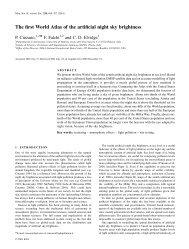slides
slides
slides
You also want an ePaper? Increase the reach of your titles
YUMPU automatically turns print PDFs into web optimized ePapers that Google loves.
New indicators of light pollution:<br />
(i) the sky irradiance (or the illuminance) on the earth surface, which has effects on<br />
the luminosity of the ground surface and on the luminosity of the night environment as<br />
perceived by animals, plants and the man (where direct irradiance by nearby lighting<br />
installations is not overwhelming);<br />
(ii) the radiation density in the atmosphere, which is the energy (or the light or the<br />
number of photons) per unit volume of atmosphere in course of transit, in an unit time, in<br />
the neighborhood of the point (x, y, z ). UNITS: photon density in ph m -3 , luminous<br />
density in Tb m -3 , where Talbot (lm * s) is the unit of luminous energy.<br />
It can be split in upward and downward radiation densities, which quantify<br />
approximately the light coming back toward the soil and going toward the outer Space.<br />
The radiation density due to direct illumination by the sources, gives the direct light<br />
travelling through a unit volume of atmosphere.<br />
(iii) the upward and downward scattered flux densities, which are the flux density of<br />
the scattered radiation; the downward one, in particular, quantifies the ”strength” of the<br />
unit volume of atmosphere at position (x, y, z ) as secondary source of light pollution<br />
when subjected to the considered light polluting action. UNITS: density of flux in ph s -1<br />
m -3 or lm m -3 .<br />
These integrated quantities are useful only as generic indictors of the alteration of the<br />
atmosphere. The effects of the atmosphere as secondary source of light pollution must<br />
be evaluated based on the intensity of light at each position .



